| Construction Rating: | starstarstarstarstar_border |
| Flight Rating: | starstarstarstarstar |
| Overall Rating: | starstarstarstarstar |
| Manufacturer: | Polecat Aerospace  |
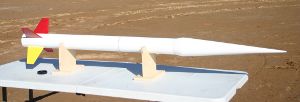
Brief:
This hard-to-resist scale sounding rocket is a sturdy 4.0" replica of the classic Nike Smoke. Polecat Aerospace
sets the stage for a memorable build by including the following historical information in their instructions:
The Nike Smoke was developed in 1959 as a vehicle for observing high altitude wind patterns generally in preparation for launching another rocket. The Nike Smoke used an air inlet at the tip of the nosecone to allow air to mix with a solution of sulfur trioxide and chlorosulfonic acid. The result was a dense smoke trail that was visible from the ground. Later versions added titanium tetrachloride and phosphorus to the smoke solution producing a more visible smoke trail. The operational version of the rocket had a service ceiling of 75,000 feet. The rocket was also flown in a two stage configuration to altitudes of 32 miles.
The kit comes with a fiberglass nose cone, fiberglass reinforced tube, a 54mm motor mount, and Baltic Birch rings and fins. Although I put a few extra features on the rocket, mine is essentially the standard kit with an additional electronics bay, payload tube, and a video camera housing.
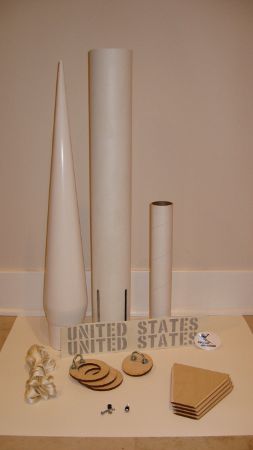
Construction:
Polecat Aerospace includes the following parts in their 4" Nike Smoke kit:
- 1 Fiberglass nosecone (28")
- 1 Nosecone bulkhead
- 1 Body tube – slotted (30")
- 4 ¼" Baltic Birch ply beveled fins
- 3 ¼" Baltic Birch ply beveled centering rings
- 1 54mm motor tube (15.5")
- 2 U-bolts
- 8 1/4" nuts
- 8 1/4" nashers
- 1 Shock cord (~11 ft)
- 2 Rail guides
- 2 #8-32 screws for rail guides
- 4 #8-32 nuts (rail guide standoffs)
- 1 "United States" decal
The kit does not come with a parachute or motor retention. I chose a 54mm Aero Pack motor retainer, sewed a Nike Smoke-themed (three red panels and one yellow) 48" hemispherical chute, and added 30' of 9/16" tubular nylon.
The instructions included with the kit have clear diagrams and describe the steps of construction well. I began construction by sanding down the nose cone and the seam on the fiberglassed tubing. The molded fiberglass nosecone has a smooth coating that requires little preparation. However, I had to sand with 60 grit sandpaper for a very long time to get the nose cone to fit inside the body tube (which is why "Construction/Finishing" receives a 4.5/5). The body tube has a slight seam from fiberglassing that sanded off fairly easily. The tube is very sturdy and gives the strength of a fiberglass tube with the weight of cardboard.
Using 30-minute epoxy, I installed the U-bolt recovery hardware in the upper centering ring. I also used 30-minute epoxy throughout the motor mount assembly. I peeled off the outer layer of tubing around the upper centering ring to ensure that the glassine coating would not simply tear off during use. (The tube absorbed the epoxy quite well when there was no glassine coating.) The middle centering ring was attached in the same fashion while leaving enough room below for a fin, bottom centering ring, and ½" of tube for the Aero Pack retainer.
I epoxied the nose cone U-bolt, which attaches in the same manner as the centering ring bulkhead. I fitted in the nose cone bulkhead and filled the gaps between the inside of the nose cone and the side of the plywood bulkhead. After some internal filleting, the nose cone was ready.
Next, I pushed the motor mount inside the tube and poured in 30-minute epoxy on the top centering ring. I tilted the tube to get epoxy between the centering ring and body tube and let the tube cure overnight. The instructions do mention using epoxy on the middle centering ring, so I hoped it would be strong enough as outlined in the instructions.
The instructions recommend no internal or external fin reinforcement (so a hard landing will break the fin off instead of splintering the plywood). However, I'd be surprised to see the stout ¼" plywood fins split, so I opted to add external fillets for cosmetic purposes. I mixed 30-Minute epoxy with a bit of micro-balloon filler. The thicker consistency of the epoxy with micro-balloons allowed for easier filleting and shaping.
I pushed in the last centering ring by sliding the Aero Pack retainer (without glue) flush with the end of the motor tube, ensuring that the retainer body made contact with the rear centering ring. From a subsequently-purchased 4.0" tube, I fashioned a small ring and placed it inside the body tube between the back centering ring and the end of the rocket in order to provide dent protection to the vulnerable tail end of the rocket.
My 4" Nike Smoke includes a payload bay for mounting an onboard video camera. Jack Garibaldi recommended the following electronics bay components: a stiff PML phenolic coupler, two bulkheads with rabbeted edges to fit inside the coupler, two ¼" all-thread rods, two U-bolts, and a sled made out of ¼" plywood. My camera setup consists of a DXG-565V video camera with an 8 gigabyte SD card (which gives approximately 2-½ hours of recording time), a "mirror" cut from a shiny piece of metal from All Electronics, and a plywood mirror housing. The mirror was easily cut with a Dremel cut-off wheel. I mounted the camera by sandwiching it between two bulkplates tightened together along the ¼" threaded rod. I cut a 1" x 1" square out of a 15" payload tube for the camera to look out and attached the mirror housing to the tube with a wide fillet of epoxy thickened with micro-balloons. The mirror was attached with 5-minute epoxy. I glued in the coupler to the payload tube after some scuffing with 60 grit sandpaper but simply friction fit the nose cone to the payload tube. I also notched out my bulkplates on the camera mount so I could run tubular nylon (the 11' given with the kit) from the top U-bolt of the e-bay to the shock cord anchor point in the nose cone, ensuring that the nose cone does not come tumbling down without a chute.
After scuffing up the motor mount tube and applying JB Weld, I attached my own 54mm Aero Pack retainer. Finally, I added the rail buttons which come with two nuts as standoffs for clearing the bulbous nose cone. I used one nut and two spacers (the washers from a 3-piece rail button), which were thicker than the two nuts. This allowed for more clearance and more spinning of the supplied guides. I drilled two 3/32" holes, tapped the first 1/4" to facilitate easy threading of the #8-32 screws, and added CA to stiffen the mounting holes. After painting, I screwed them in for flight and made sure the guides spun freely.
Finishing:
After sanding away the seam on the tube, I lightly sanded the entire rocket with 180 grit sandpaper. The rocket was
covered with Krylon gloss white after priming and sanding a few times. I opted to use the traditional color scheme of a
white body, three red fins, and one yellow fin.
The gloss white fills in the remaining weave pattern well and makes for a bright, shiny main color. I used semi-metallic red for three fins and flat yellow on the last fin. I did not attach my "United States" decal as I like the simplicity of the rocket's paint scheme, however, it is a high quality decal!
Construction Rating: 4 out of 5
Flight:
The icy lake bed was a scenic setting for the February 2009 ROC launch near Los Angeles. I loaded the rocket with an
AeroTech I161W-S, secured it with the Aero Pack, packed the 48" chute and Nomex®,
armed the camera, and launched. The rocket gently rose off the rail on the I161W with a huge plume of smoke, arced
over, and deployed the chute. As the rocket seemed underpowered on its first flight, Jack Garabaldi suggested a
Cesaroni I800 Vmax. This time, the super quick burn popped the rocket off the pad, and the rocket again floated down
safely. David Reese nicely captured a photograph of my 4" Nike Smoke's launch on the I800 Vmax.
At ROCStock 29 (June 2009), I celebrated the CSFM approval of Skidmarks by flying an I223-7 SK. Although the delay was a bit short, the sparky motor gave a great onboard video of the 4" Nike Smoke's flight.
The rocket has also been flown without the payload bay in stock configuration. It flew great on a H112J and I245G.
Polecat Aerospace recommends using any motor from a high thrust G through a K motor. Because I modified the stock kit with a payload section, large chute and heavy duty recovery system, and a camera, I wouldn't fly it on anything less than an I motor. My rocket weighted in at approximately 7.5 lbs loaded, nearly 4 pounds greater than the manufacturer listed weight of 3.5lbs. I have confidence that the stock kit can fly in the recommended motor range.
PROs: Accepts a wide range of motors (from G to K). Simple to prepare. Flies straight, even in a light breeze!
CONs: None.
Recovery:
Polecat Aerospace supplies U-bolts for recovery harness attachment and 11' section of tubular nylon. I used the 11'
piece of tubular nylon to attach the nose cone to the electronics bay and added another 30 feet of wider (9/16")
tubular nylon because I had added a heavy payload section. One note on recovery: as the additional 30 feet of tubular
nylon, deployment bag, and chute did not fit well in the shortened recovery space, I opted to use two 12" Nomex®
chute protectors instead of the deployment bag. I also added a 24" pilot chute to the top of the main chute.
PROs: No parachute: leaves flexibility for builder. Strong U-bolt attachment points. Strong tubular nylon.
CONs: A bit short on space for recovery gear if you include a payload bay at the end of the recovery space.
Flight Rating: 5 out of 5


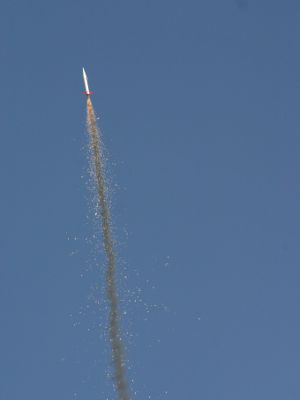
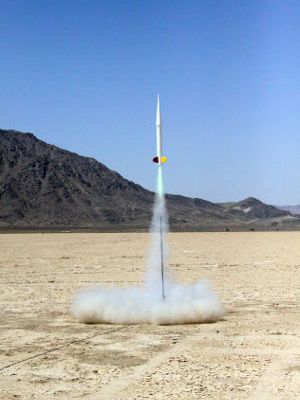
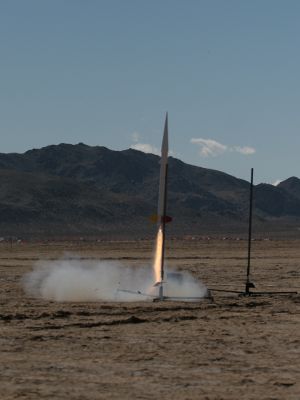

Summary:
PROs: Pre-glassed tube. Durable nose cone. High quality fins and rings. Accepts a wide range of motors (high thrust
G-K). Flexible recovery and motor retention systems – left up to builder. Welcomes modifications (such as an
onboard video camera). Great customer service.
CONs: Nose cone too tight without heavy sanding. Tight on space for recovery components if electronics are added.
This rocket is a great high power build, has high quality components, and is certainly a crowd pleaser!
Overall Rating: 5 out of 5
 |
 |
Sponsored Ads
 |
 |












B.C. (April 4, 2010)